|
 |
- Product Overview
- Operational Instructions
- Downloads
- Technical Specifications
| The AME MULTI-POSITION RECLINER HTR
Tilt and recline features, smooth and effortless operation, and optimal positioning. They are also designed to provide maximum safety for both the user and the caregiver. The HTR features 24" rear wheels and 8" front casters for maneuverability and controlled steering. The HTR has a pan seat for use with pressure relief cushions. So look to our full and diverse line to provide the utmost in support, comfort, and ease of use. |
 |
 |
| |
| |
| KEY PRODUCTS FEATURES |
- 5in casters, 3-swivel-locking, headwings - Seat pan option available for use with pressure-relief cushions- Contoured seat and back cushion enhance comfort- Sliding seat lock for easy seat-depth adjustment- Fully integrated, adjustable molded tray improves functionality- Fold-down back facilitates transfers and personal grooming- Wide range of optional accessories: IV pole, handrim, elevating legrests, headrest extension, abduction pommel, front anti-tippers, and seat belt
- Contoured headrest, seat cushion, and tray standard only on model 5500
- One-directional-locking (models 3000-3500 only)
- Recline adjusts from 90 degrees to 125 degrees for better support, comfort, and positioning
- Tilt adjustment positions the user and improves tolerance and functionality
|
| PRODUCT FEATURES |
| |
TILT OPERATION
Infinite tilt positions are controlled by the trigger cable
mechanism located behind the chair on the right push
handle. Squeeze the trigger and the lock is released,
allowing the chair to be pulled back or eased forward to
the desired degree of tilt. Release the trigger and the unit will lock into the chosen degree of tilt. To assist in this function, there is a descent/ascent footbar so your arms are not doing all the work. |
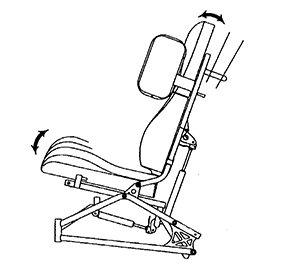 |
| |
RECLINE
Infinite recline positions are also controlled by a single
trigger cable mechanism located behind the chair. The
recline control mechanism is located on the left push
handle 90 degrees to the back. Squeeze the trigger and
the back is released, allowing the seat to back angle to
be adjusted accordingly. Release the trigger and the back will be locked at the chosen degree of recline. |
 |
| |
FLIPDOWN BACK OPERATION
To flip down the back, pull simultaneously on the two pins located in the vertical members of the back. Allow the upper portion of the back to swing down behind the lower portion. To return the back to its upright position, swing the back up and it will automatically lock in position. |
 |
| |
| |
| PRODUCT OVERVIEW |
| 1. |
Percentage of Weight Distribution
Many activities require the HTR user to reach, bend and transfer in and out of the HTR. These movements will cause a change to the normal balance, the center of gravity, and the weight distribution of the HTR. To determine and establish your particular safety limits, practice bending, reaching and transferring activities in several combinations in the presence of a qualified healthcare professional BEFORE attempting active use of the HTR. Proper positioning is essential for your safety. When reaching, leaning, or bending forward, it is important to use the front casters as a tool to maintain stability and balance. |
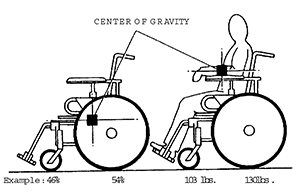 |
| 2. |
Functional Reach From the HTR
The approximate reach-limit values shown in the accompanying graphs were derived on the basis of a sample of 91 male and 36 female subject users. Note the difference between the maximum and the comfortable reach limits, a subjective but important consideration in design. |
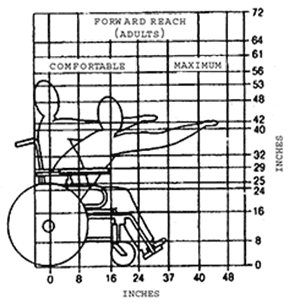 |
| 3. |
Reaching, Leaning and Bending Forward
Position the front casters so that they are extended as far forward as possible and engage wheel locks. |
 |
| 4. |
Reaching, Leaning - Backwards
Position the HTR as close as possible to the desired object. Point front casters forward to create the longest possible wheelbase. Reach back only as far as your arm will extend without changing your sitting position. |
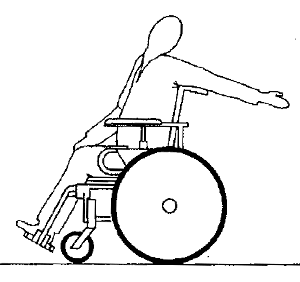 |
| 5. |
Tilting - Curbs Method One
When tilting the HTR, an assistant should grasp the back of the HTR on a non-removable (non-detachable) part. Inform the HTR occupant before tilting the HTR and remind him/her to lean back. Be sure the occupant’s feet and hands are clear of all wheels. After mastering the techniques of tilting the HTR, use this procedure to tackle curbs, short stairs, etc. METHOD 1 - Apply a continuous downward motion until the balance point is achieved and the front casters clear the curb. At this point, the assistant will feel a difference in the weight distribution. Roll the HTR forward and slowly lower the front casters onto the sidewalk. Do not let the HTR drop the last few inches to the ground. This could result in injury to the occupant. Push the HTR forward until the rear wheels roll up and over the curb. |
 |
| 6. |
Tilting - Curbs Method Two
This method requires two (2) assistants. The second assistant should be positioned at the front of the HTR lifting upward on a non-removable (nondetachable) part of the HTR frame when lifting the HTR and stabilizing the HTR when the HTR is being lowered to the ground. The first assistant should stand on the sidewalk and turn the HTR so that the rear wheels are against the curb. The HTR should be tilted back to the balance point and, in one continuous upward movement, the rear wheels should be pulled up and over the curb. DO NOT return the front casters to the ground until the HTR has been pulled backward far enough for the front casters to clear the edge of the curb. |
 |
| 7. |
Transferring to and From Other Seats
Position the HTR as close as possible along side the seat to which you are transferring, with the front casters pointing parallel to it. Engage wheel locks. Shift body weight into seat with transfer.
During independent transfer, little or no seat platform will be beneath you. Use a transfer board if at all possible |
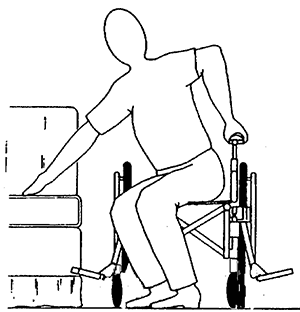 |
|
| 
|
| TECHNICAL SPECIFICATIONS |
| Overall Height: |
50" |
| Overall Width: |
27"/29" |
| Overall Depth: |
Upright: 39" Recline: 52" |
| Seat Width: |
16" or 18" |
| Seat Depth: |
16" - 20" |
| Seat To Back Height: |
34" |
| Seat To Floor Height: |
20" or 22" |
| Seat Tilt: |
0° - 35° |
| Recline Angle: |
95° - 125° |
| Dimensions: |
Tray: 16"W or 18"W x 23.25"L Carton: 46"L x 33"W x 41.5"H
|
| Product Weight Capacity: |
250 lb
|
| Product Weight: |
16/18 wide: 88 lb/91 lb
|
| Shipping Product Weight: |
16/18 wide: 136 lb/139 lb
|
| Warranty: |
Chair: 3 years Upholstery: 1 year |
| |
|
|